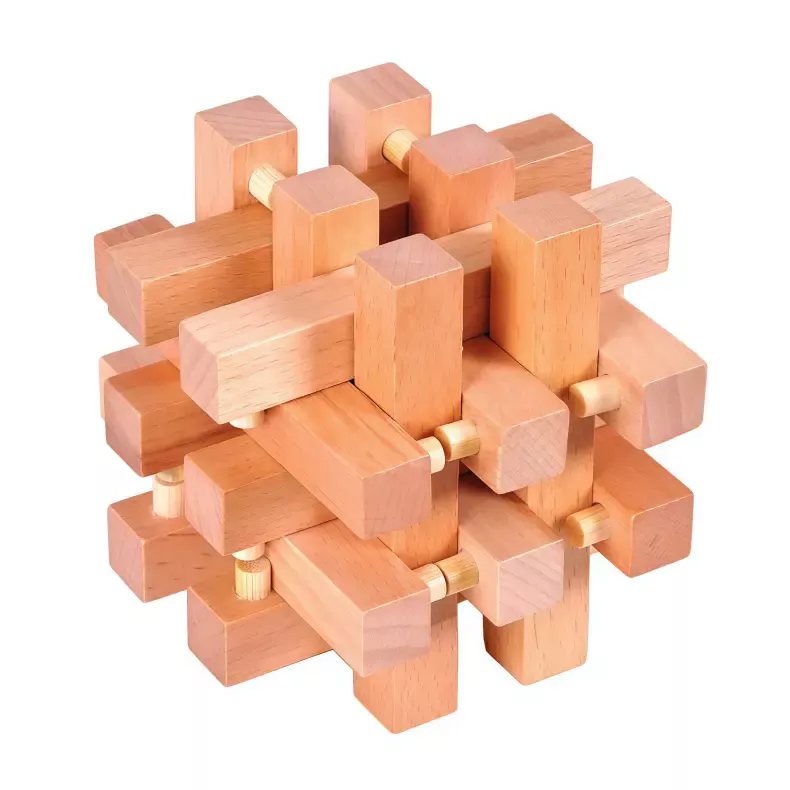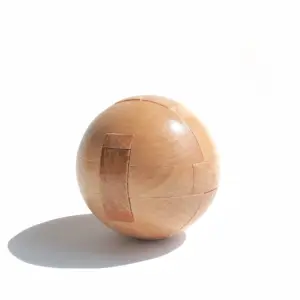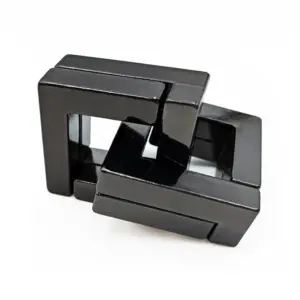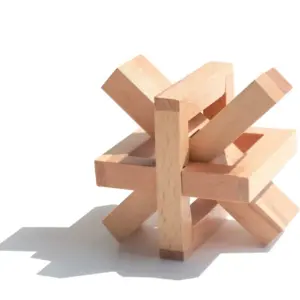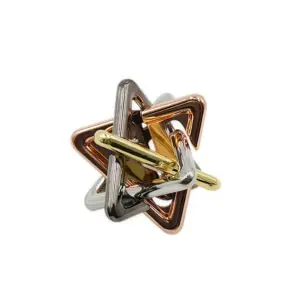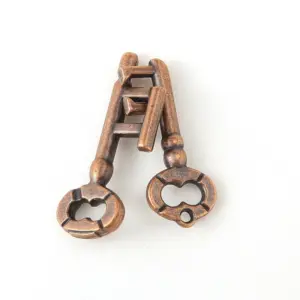I’ve been reviewing puzzles for the better part of a decade, and I’ll be straight with you—the 18-Piece Wooden Puzzle humbled me. Not in a “throw it across the room” kind of way (though I came close), but in that sneaky manner where you think you’ve cracked it, only to realize seventeen pieces are now mocking you from your living room floor.
This isn’t your grandma’s jigsaw puzzle. This is an interlocking wooden brain teaser that operates on principles older than your neighborhood, wrapped in deceptively simple engineering. Think of it as IKEA furniture’s smarter, more patient cousin—except instead of assembling a bookshelf, you’re wrestling with spatial geometry that would make Euclid sweat.
What Exactly Is the 18-Piece Wooden Puzzle?
Let’s break down what you’re actually getting. The 18-Piece Wooden Puzzle—sometimes called a Luban Lock or interlocking burr puzzle—consists of eighteen individual wooden pieces that fit together in one specific configuration. No glue, no screws, no magnets. Just pure mechanical precision.
Here’s where it gets interesting. You’ve got seventeen identical pieces (what I call the “standard crew”) and one oddball piece (the “key”). Each standard piece is a rectangular wooden bar with cylindrical pegs—or “teeth”—sticking out from both ends. These teeth are what lock everything together, creating friction and structure.
Quick Anatomy Lesson:
- Standard Pieces (17x): Rectangular bars with pegs on both ends
- Key Piece (1x): Identical bar but with only ONE pegged end—the other end is smooth
- Material: Usually hardwood (beech, oak, or walnut)
- Finish: Natural wood or light varnish
That single smooth-ended piece? That’s your secret weapon. It’s the last piece in, the first piece out, and the reason this whole contraption doesn’t immediately collapse into kindling.
Taking It Apart: The Easy Part (Seriously)
Disassembly is almost embarrassingly simple, which is why it lures you into a false sense of confidence. Here’s how it goes:
- Locate the key piece: Scan the assembled puzzle for the one piece with a smooth end. It’ll be flush with the structure, not sticking out awkwardly.
- Pinch and pull: Grab that smooth end between your thumb and forefinger. Pull straight out—no twisting, no force. It should slide out like butter.
- Watch the domino effect: Once the key is out, the remaining seventeen pieces lose their structural integrity. They’ll loosen up, and you can gently separate them one by one.
The whole process takes maybe thirty seconds. Congratulations! You’ve just deconstructed a centuries-old mechanical puzzle. Now comes the fun part.
Putting It Back Together: Where Things Get Spicy
I’m not going to sugarcoat this—reassembling the 18-Piece Wooden Puzzle is where most people hit a wall. I’ve watched grown adults stare at eighteen wooden sticks like they’re decoding the Rosetta Stone. But here’s the thing: it’s not about intelligence. It’s about patience, spatial reasoning, and following a very specific sequence.
Step 1: Build Your Foundation
Start with two standard pieces standing vertical, pegs pointing up. Think of them as goalposts. Now lay two more pieces horizontally across the top—these should rest close to the lower pegs. You’re building a hashtag (#) shape here.
Next, add two more vertical pieces on the sides, but this time flip them—pegs pointing down. These should face inward toward your initial vertical pair, creating an “H” profile when viewed from the front.
Two more pieces go front and back, pegs down, mirroring that H-shape. You now have a basic cube framework made from eight pieces. Don’t celebrate yet.
Step 2: Fill the Gaps (This Is Where I Lost My Mind)
Here’s the trick nobody tells you: the next pieces don’t go in simultaneously. You’re working left-right independently now.
Grab a piece in your left hand, peg facing right. Slide it down along the left vertical pieces until it wedges into the gap. Do the same with your right hand—peg facing right again—threading it down the right side. Both pieces should lock into the central cavity.
Add another piece, peg facing left this time, sliding down to meet its partner. Then comes a piece with the peg pointing downward—jam it straight into the middle gap between existing pieces.
Repeat this pattern: right-facing pegs on the sides, downward pegs in the center. It’s like a dance where you’re constantly checking orientation before every move.
Step 3: The Rotation Trick (AKA The Secret Sauce)
Once all seventeen standard pieces are in, your puzzle will feel… floppy. Loose. Like it’s held together by good intentions and vibes. This is normal. Here’s the magic move:
- Cup both hands around the middle section
- Carefully pull out the bottom two pieces (your original base)
- Rotate the entire structure 90 degrees toward you
- Push the two middle pieces (now facing you) inward
- Reinsert those bottom pieces, pegs facing inward
- Push the compressed pieces back out to their original position
Suddenly, everything tightens up. The pieces grip each other. That floppy mess becomes a solid block.
Step 4: Insert the Key
Final move: grab your key piece. Smooth end goes in first, pegged end trailing behind, peg pointing downward. Slide it into the remaining gap like threading a needle.
When it clicks home, give the whole assembly a gentle shake. If nothing moves, you’ve done it. If pieces shift, you messed up the rotation step—disassemble and try again.
18 Piece Wooden Puzzle
- Silent Mastery in Your Hands: The 18-Piece Wooden Puzzle teaches what words cannot—that true knowledge reveals itself through action, not announcement. Seventeen identical pieces plus one “key” piece interlock with zero wiggle room, proving that harmony emerges when individual strength bows to collective balance. Perfect for those who understand that the loudest victories often happen in complete silence.
- Challenge That Respects Intelligence: This isn’t a gimmick—it’s a four-star wooden brain teaser designed for adults, teens, and anyone tired of puzzles that insult their capabilities. Disassembly takes seconds; reassembly demands focus, spatial reasoning, and the patience to understand that forcing pieces never works. Whether displayed on your desk or gifted to a problem-solver, this interlocking wooden puzzle becomes a conversation starter that doesn’t need words to impress.
Difficulty Rating: Is It Really That Hard?
The 18-Piece Wooden Puzzle typically gets a four-star difficulty rating, and I’d say that’s fair. Here’s my breakdown:
✓ What Makes It Manageable
- Disassembly is dead simple
- Only 18 pieces (not overwhelming)
- Clear visual feedback when pieces align
- Once you “get” it, you’ve got it forever
✗ What Makes It Challenging
- That rotation step is completely unintuitive
- Peg orientation matters EVERY time
- Easy to lose track of which pieces go where
- Requires genuine spatial reasoning
First-timers? Budget 45 minutes to two hours. By your third attempt, you’ll have it down to ten minutes. It’s one of those puzzles where the learning curve is steep but short.
Who’s This Puzzle Actually For?
After testing this with everyone from my nephew (age 12) to my retired engineer neighbor (age 68), here’s who gets the most out of the 18-Piece Wooden Puzzle:
- Puzzle enthusiasts looking for mechanical challenges: If you’re bored with flat jigsaws, this adds a whole dimension (literally)
- Adults who fidget at desks: It’s the sophisticated alternative to stress balls—solve it, scramble it, solve again
- Teens with good attention spans: Great for kids 14+ who enjoy problem-solving without screens
- Gift-givers who want something memorable: Way more interesting than another gift card
- People who appreciate craftsmanship: The wood quality and precision cuts are genuinely impressive
Who should skip it? Anyone expecting instant gratification, people with limited dexterity (those pegs are small), or folks who get genuinely frustrated by puzzles. This is a slow-burn satisfaction, not a dopamine hit.
The Honest Review: What I Actually Think
Let me put my reviewer hat back on. I’ve handled dozens of wooden brain teasers, and the 18-Piece Wooden Puzzle sits comfortably in the “quality mid-tier” category. It’s not a fifty-dollar artisan masterpiece, but it’s not cheap dollar-store garbage either.
What I Love
The precision is no joke. When pieces lock together, there’s zero wiggle. That’s proper engineering, not luck. The wood itself—usually beech or similar hardwood—feels substantial. It’s got weight. It smells like actual wood, not plastic pretending to be wood.
The difficulty sweet spot is perfect. It’s hard enough to feel accomplished when you solve it, but not so brutal that you’ll abandon it in a drawer. That balance is trickier to achieve than you’d think.
Repeatability is high. Unlike a jigsaw where you solve it once and you’re done, this puzzle resets instantly. I keep mine on my desk specifically for those moments when I need a five-minute mental break.
What Could Be Better
Instructions are often garbage. Most versions come with either no guide or a poorly translated pamphlet that assumes you already know how it works. Thank god for YouTube tutorials (like the one embedded above).
Size is smaller than photos suggest. Each piece is roughly 3-4 inches long. Not a dealbreaker, but if you’ve got large hands or poor fine motor control, you might find the assembly fiddly.
Quality varies wildly by manufacturer. I’ve seen versions where one piece had a rough edge that prevented smooth assembly. Check reviews before buying—reputable sellers matter here.
Common Mistakes (And How to Avoid Them)
After watching people struggle with this puzzle, three mistakes come up repeatedly:
- Forcing pieces that don’t want to go. If you’re applying significant pressure, you’re doing it wrong. Every piece should slide into place with minimal force.
- Skipping the rotation step. People assemble all 17 standard pieces, try to jam in the key, and wonder why nothing locks. You MUST do that compression rotation before the key fits.
- Losing track of peg orientation. It’s easy to grab a piece and insert it backward. Always check which way your pegs are pointing before sliding a piece home.
Pro Tip: Work on a solid-colored surface (like a desk mat or large sheet of paper). Wooden pieces on a wooden table create visual confusion. A contrasting background helps immensely.
Where to Buy & What to Pay
The 18-Piece Wooden Puzzle typically runs between $20-$40 depending on wood quality and brand. I’d avoid anything under $15—at that price point, you’re likely getting soft wood with imprecise cuts.
Look for sellers who explicitly mention:
- Wood type (hardwood like beech or oak, not pine)
- Precision-cut pieces
- Smooth finish (no splinters)
- Assembly guide or video link
Amazon, Etsy, and specialty puzzle retailers all stock versions. Read recent reviews—quality control can be inconsistent across production runs.
Final Verdict: Should You Buy It?
If you’re still reading this far, you’re probably already sold. But let me make it explicit: yes, the 18-Piece Wooden Puzzle is worth your money—assuming you understand what you’re getting.
This isn’t a casual coffee-table toy you’ll master in five minutes while waiting for dinner to cook. It’s a legitimate brain teaser that demands focus, rewards patience, and provides that increasingly rare sensation of “I actually figured something out without Googling the answer.”
It’s tactile in a way that screens can never replicate. It’s challenging without being cruel. And once you’ve conquered it, you get to experience the smug satisfaction of watching someone else struggle while you casually mention, “Oh yeah, that rotation trick gets everyone.”
Ready to Test Your Spatial Skills?
Grab your own 18-Piece Wooden Puzzle and see if you can beat my first-attempt time of 97 minutes (not that I’m competitive or anything). Just remember: when you inevitably get stuck, the video solution is right there at the top of this page.
Pro tip: Buy two. One for yourself, one as a gift. Trust me on this.
Frequently Asked Questions
How long does it take to solve the 18-Piece Wooden Puzzle?
First attempt? Anywhere from 30 minutes to 3 hours depending on your spatial reasoning skills. By your third try, you’ll have it down to 10-15 minutes. Expert solvers can reassemble it in under 2 minutes.
Is this puzzle suitable for kids?
I’d recommend ages 12+ due to the small pieces and complexity. Younger kids with exceptional patience might handle it, but most will get frustrated. It’s genuinely more of an adult brain teaser.
Can you solve it differently, or is there only one solution?
There’s only one correct configuration. The beauty (and frustration) is that every piece has to go in a specific sequence with specific orientation. No shortcuts, no alternate paths.
What if I lose a piece?
You’re out of luck. This isn’t like a jigsaw where you can still see most of the picture. Lose one piece, and the whole puzzle becomes unsolvable. Store it carefully when not in use.
How does this compare to other wooden puzzles?
It’s mid-range difficulty. Easier than six-piece burr puzzles or complex dissection puzzles, but significantly harder than basic shape-sorting wooden toys. The unique selling point is the mechanical interlocking system.


